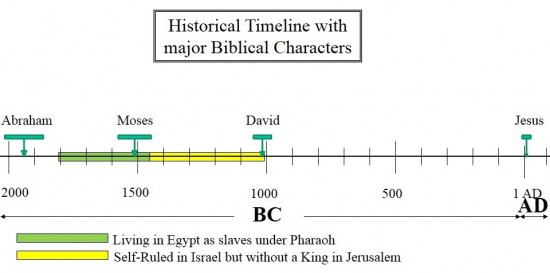Jews have a long history in India, being here for thousands of years, forming a small community within the mosaic of Indian communities. Different than other minorities (such as Jains, Sikhs, Buddhists), the Jews originally came from outside India to make their home. Just before the historic visit of Indian Prime Minister Modi to Israel in summer 2017 he penned a joint op-ed with Netanyahu, the Prime Minister of Israel. They recognized this migration of Jews to India when they wrote:
The Jewish community in India was always welcomed with warmth and respect and never faced any persecution.
In fact, Jews have had a profound effect on the history of India, providing a solution to a stubborn mystery in Indian history – how did writing emerge as it did in India? The answer to this question impacts all the classical works of Indian culture.
Jewish History in India

How long have Jewish communities been in India? The Times of Israel recently published an article highlighting that after ’27 centuries’ Jews from the tribe of Manasseh (Bnei Menashe) are returning to Israel from Mizoram. That puts their ancestors originally arriving here around 700 B.C. Their Telugu-speaking cousins from the Jewish tribe of Ephraim living in Andhra Pradesh (the Bene Ephraim) have a collective memory of being in India more than 1000 years, after wandering through Persia, Afghanistan, Tibet, and then China. In Kerala, the Cochin Jews have been living there nearly 2600 years. Over the centuries Jews formed small but distinct communities across India. But now they are leaving India for Israel.

How did Jews come to live in India? Why are they returning after so long back to Israel? We have more facts about their history than that of any other nation. We will use this information to summarize their history using a timeline.
Abraham: The Jewish Family Begins
The timeline starts with Abraham. He was given a promise of nations and had encounters with God ending in the symbolic sacrifice of his son Isaac. This was a sign pointing to Jesus (Yeshu Satsang) by marking the future location of his sacrifice. Isaac’s son was named Israel by God. The timeline continues in green when Israel’s descendants were slaves in Egypt. This period started when Joseph, son of Israel (the genealogy was: Abraham -> Isaac -> Israel (also known as Jacob) -> Joseph), led the Israelites to Egypt, where later on they were enslaved.
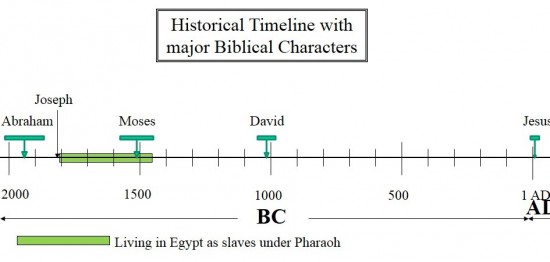
Moses: The Israelites become a Nation under God
Moses led the Israelites out of Egypt with the Passover Plague, which destroyed Egypt and freed the Israelites from Egypt into the land of Israel. Before he died, Moses pronounced Blessings and Curses on the Israelites (when the timeline goes from green to yellow). They would be Blessed if they obeyed God, but Cursed if they did not. Israel’s history was bound to these Blessings & Curses ever after.
For several hundred years the Israelites lived in their land but they did not have a King, nor did they have the capital city of Jerusalem – it belonged to other people in this time. However, around 1000 BC this changed with King David.

David establishes a Royal Dynasty at Jerusalem
David conquered Jerusalem and made it his capital city. He received the promise of a coming ‘Christ’ and from that time on the Jewish people waited for the ‘Christ’ to come. His son Solomon, rich and famous, succeeded him and built the First Jewish Temple on Mount Moriah in Jerusalem. The descendants of King David continued to rule for about 400 years and this period is shown in aqua-blue (1000 – 600 BC). This was the period of Israelite glory – they had the promised Blessings. They were a powerful nation; had an advanced society, culture, and their Temple. But the Old Testament also describes their growing corruption during this time. Many prophets in this period warned the Israelites that the Curses of Moses would come on them if they did not change. These warnings were ignored. During this time the Israelites divided into two separate kingdoms: the northern Kingdom of Israel or Ephraim, and the southern Kingdom of Judah (like Koreans today, one people split in two countries – North and South Korea).
The First Jewish Exile: Assyria & Babylon
Finally, in two stages the Curses came upon them. The Assyrians in 722 BC destroyed the Northern Kingdom and sent those Israelites into mass deportation across their vast empire. The Bnei Menashe in Mizoram and the Bene Ephraim in Andhra Pradesh are descendants of those deported Israelites. Then in 586 BC Nebuchadnezzar, a powerful Babylonian King came – just like Moses had predicted 900 years before when he wrote in his Curse:
The Lord will bring a nation against you from far away … a fierce-looking nation without respect for the old or pity for the young. … They will besiege all the cities throughout the land. (Deuteronomy 28: 49-52)
Nebuchadnezzar conquered Jerusalem, burned it, and destroyed the Temple that Solomon had built. He then exiled the Israelites to Babylon. This fulfilled the predictions of Moses that
You will be uprooted from the land you are entering to possess. Then the Lord will scatter you among all nations, from one end of the earth to the other. (Deuteronomy 28:63-64)

The Jews of Cochin in Kerala are descendants of these exiled Israelites. For 70 years, the period shown in red, these Israelites (or Jews as they were now called) were exiled outside the land promised to Abraham and his descendants.
Jew’s Contribution to Indian Society
We pick up the question of writing which emerged in India. The modern languages of India including Hindi, Bengali, Marathi, Gujarati, Telugu, Kannada, Malayalam and Tamil as well as ancient Sanskrit in which the Rg Vedas and other classical literature was written are classified as Brahmic scripts since they all descend from an ancestral script known as Brahmi script. Brahmi script today is only seen in a few ancient monuments from the Ashoka Emperor period.

Though it is understood how the Brahmi script changed into these modern scripts, what is not clear is how India first adopted the Brahmi script. Scholars note that the Brahmi script is related to the Hebrew-Phoenician script, which was the script used by the Jews of Israel in the period of their exiles and migration to India. Historian Dr. Avigdor Shachan (1) proposes that the exiled Israelites who settled in India brought the Hebrew-Phoenician with them – which became the Brahmi script. This also solves the mystery of how the Brahmi script got its name. Is it just coincidence that the Brahmi script appears in North India at the same time when the Jews settled there in exile from their ancestral land, the land of Abraham? The natives who adopted the script of Abraham’s descendants called it the (A)brahamin script. Abraham’s religion was belief in one God whose role is not limited. He is first, last, and eternal. Perhaps this is where the belief in Brahman also arose, from the religion of (A)braham’s people. The Jews, in bringing their script and religion to India, shaped its thought and history more fundamentally than the many invaders who sought to conquer and rule her. And the Hebrew Vedas, originally in Hebrew-Phoenician/Brahmi script, has its theme of the Coming One, in common with the Sanskrit Rg Vedas theme of Coming Purusa.
But we return to the history of the Jews in the Middle East after their exile from their ancestral land.
Return from Exile under the Persians
In 539 BC, the Persian Emperor Cyrus conquered Babylon and he became the most powerful person in the world. Cyrus permitted the Jews to return to their land.

However they were no longer an independent country, they were now a province in the Persian Empire. This continued for 200 years and is in pink in the timeline. During this time the Jewish Temple (known as the 2nd Temple) and the city of Jerusalem were rebuilt. Though Jews were allowed to return to Israel, many remained abroad in exile.
The Period of the Greeks
Alexander the Great conquered the Persian Empire and made Israel a province in the Greek Empire for another 200 years. This is shown in dark blue.
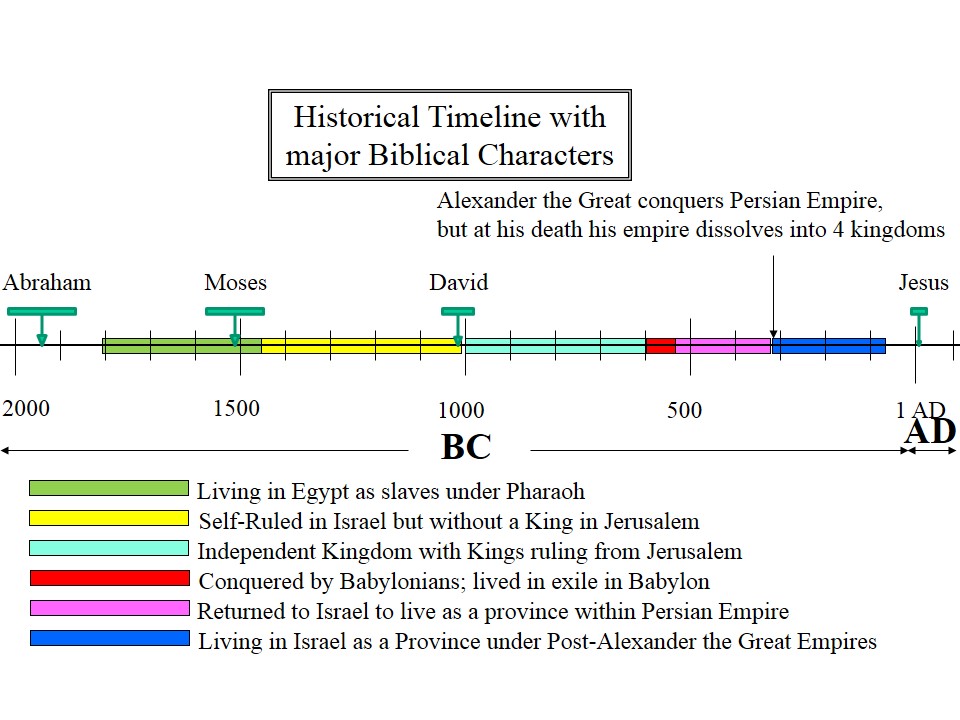
The Period of the Romans
Then the Romans defeated the Greek Empires and they became the dominant world power. The Jews again became a province in this Empire and it is shown in light yellow. This is the time when Jesus lived. This explains why there are Roman soldiers in the gospels – because the Romans ruled the Jews in Israel during the life of Jesus.
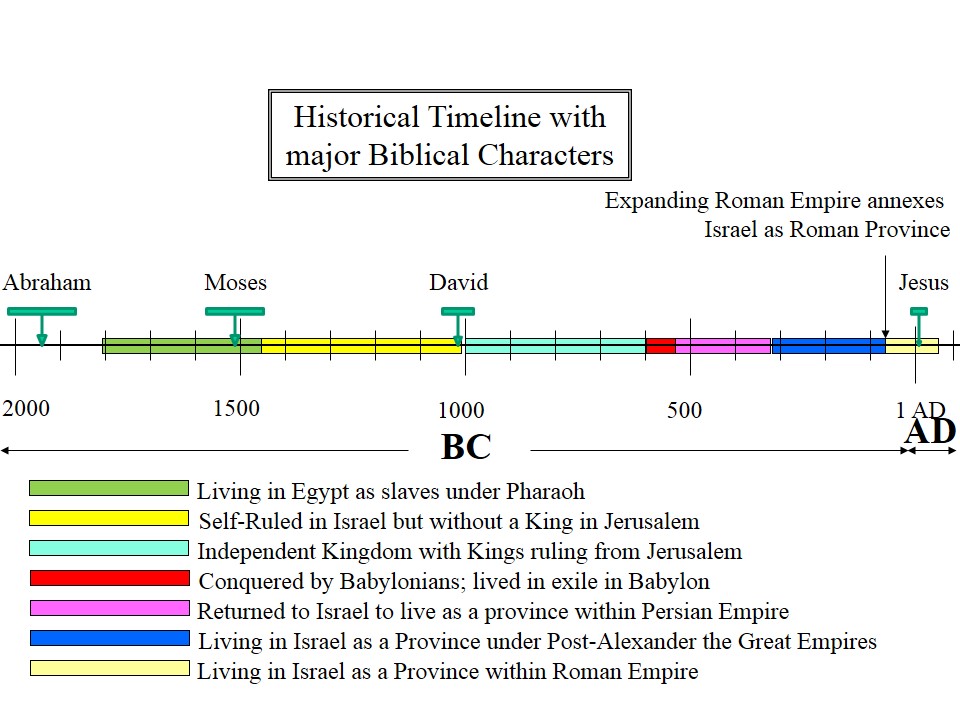
The Second Jewish exile under the Romans
From the time of the Babylonians (586 BC) the Jews had not been independent as under the Kings of David. They were ruled by other Empires, similar to how the British ruled India before independence. The Jews resented this and they revolted against Roman rule. The Romans came and destroyed Jerusalem (70 AD), burned down the 2nd Temple, and deported the Jews as slaves across the Roman Empire. This was the second Jewish exile. Since Rome was so big the Jews were eventually scattered around the whole world.
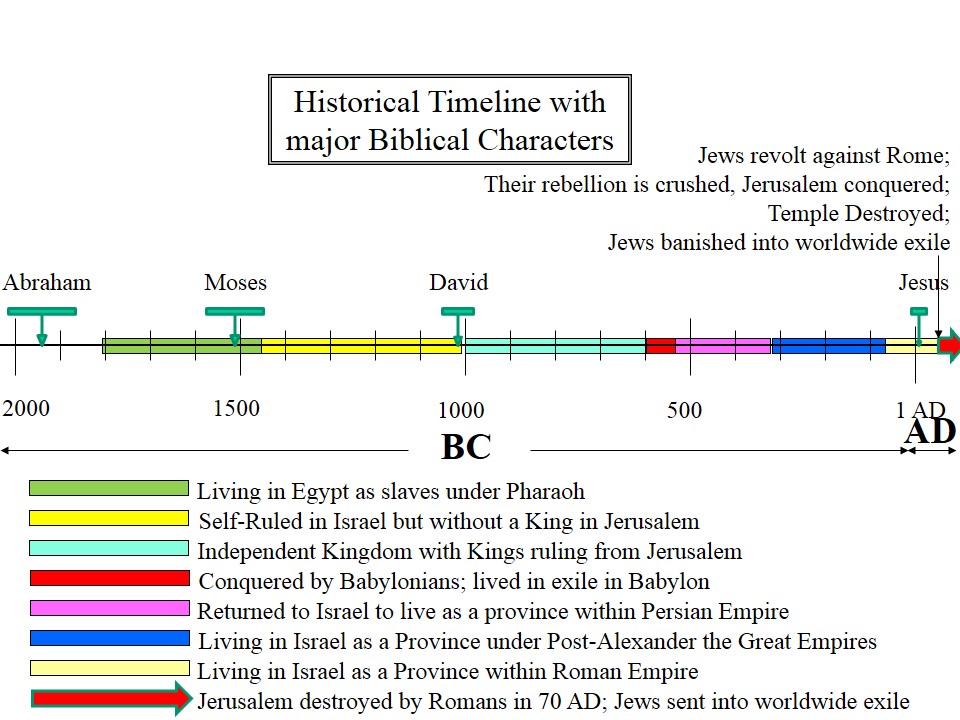
This is how the Jewish people lived for almost 2000 years: dispersed in foreign lands and never accepted in these lands. In these different nations they regularly suffered great persecutions. This persecution of the Jews was particularly true in Europe. From Spain, in Western Europe, to Russia the Jews lived often in a dangerous situations in these kingdoms. Jews continued arriving in Cochin to escape these persecutions. Jews from the Middle East arrived in other parts of

India in the 17th and 18th centuries, and were known as the Baghdadi Jews, settling mostly in Mumbai, Delhi and Calcutta. The Curses of Moses back in 1500 BC were accurate descriptions of how they lived.
… Among those nations you will find no repose, no resting place for the sole of your foot. There the Lord will give you an anxious mind, eyes weary with longing, and a despairing heart. (Deuteronomy 28:65)
The Curses against the Israelites were given to make peoples ask:
All the nations will ask: “Why has the Lord done this to this land? Why this fierce, burning anger?” (Deuteronomy 29:24)
And the answer:
“It is because this people abandoned the covenant of the Lord, the God of their ancestors, the covenant he made with them when he brought them out of Egypt. They went off and worshiped other gods and bowed down to them, gods they did not know, gods he had not given them. Therefore the Lord’s anger burned against this land, so that he brought on it all the curses written in this book. In furious anger and in great wrath the Lord uprooted them from their land and thrust them into another land, as it is now.” (Deuteronomy 29:25-28)
The timeline below shows this 1900-year period. This period is shown in a long red bar.

You can see that in their history the Jewish people went through two periods of exile but the second exile was much longer than the first exile.
The 20th Century Holocaust
The persecutions against the Jews reached their peak when Hitler, through Nazi Germany, tried to exterminate all the Jews living in Europe. He almost succeeded but he was defeated and a remnant of Jews survived.
Modern Re-birth of Israel
The fact that there were people who self-identified as ‘Jews’ after thousands of years without a homeland was remarkable. But this allowed the final words of Moses, written down 3500 years ago, to come true. In 1948 the world, through the United Nations, saw the incredible re-birth of the modern state of Israel, as Moses had written centuries before:
…then the Lord your God will restore your fortunes and have compassion on you and gather you again from all the nations where he scattered you. Even if you have been banished to the most distant land under the heavens, from there the Lord your God will gather you and bring you back. He will bring you to the land that belonged to your ancestors, and you will take possession of it. He will make you more prosperous and numerous than your ancestors. (Deuteronomy 30:3-5)
It was also remarkable since this state was established in spite of great opposition. Most of the surrounding nations waged war against Israel in 1948 … in 1956 … in 1967 and again in 1973. Israel, a very small nation, was sometimes at war with five nations at the same time. Yet not only did Israel survive, but her territory increased. In the 1967 Six-Day War, Israel regained Jerusalem, her historic capital city David had founded 3000 years ago. The result of the creation of the state of Israel, and the consequences from these wars has created one of the most difficult geo-political problems of our world today.
As predicted by Moses and explored more fully here, the re-birth of Israel created an impetus for the Jews in India to return back to Israel. There are now 80 000 Jews living in Israel who have one parent from India and there are only 5000 Jews left in India. As per Moses’ blessing they are being ‘gathered’ from the most ‘distant lands’ (like Mizoram) and being brought ‘back’. Moses wrote that both Jews and non-Jews should note the implications. The incarnation of (A)brahman in Jesus is explored here.
- Avigdor Shachan. In the Footsteps of the Lost Ten Tribes p 261
